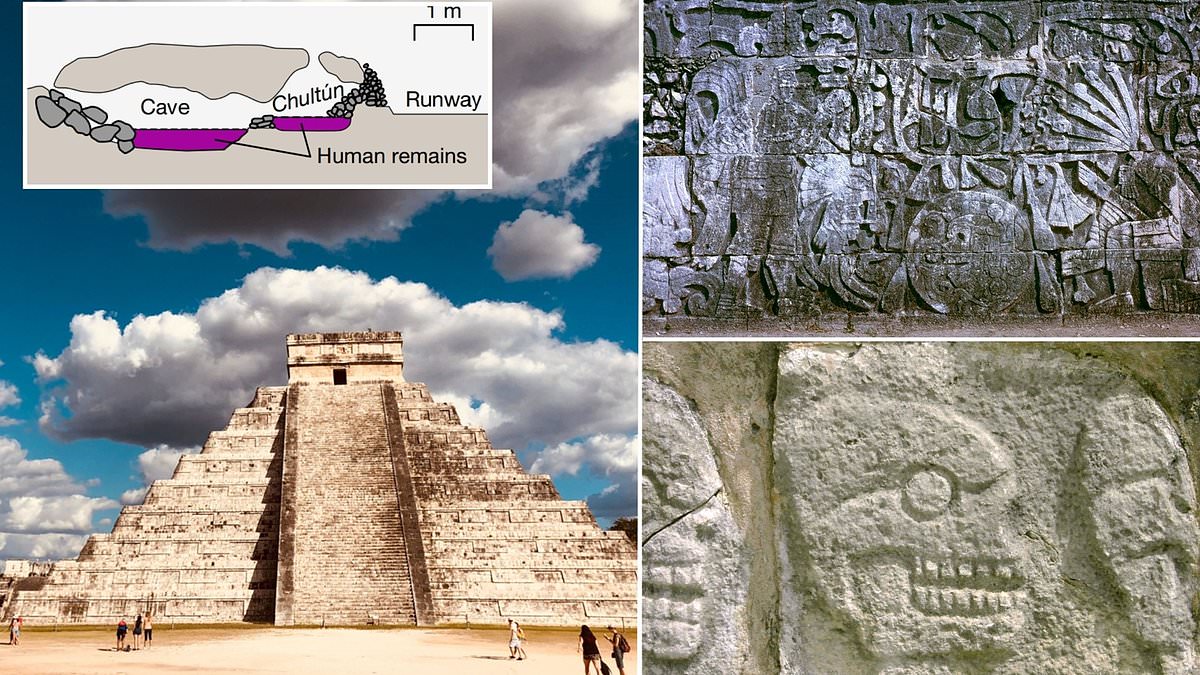Today, the ruined city of Chichén Itzá in Mexico is a major tourist attraction, drawing around two million people from around the world each year.
Chichén Itzá’s stunning ancient buildings – including the famous El Castillo pyramid, nearly 100 feet tall – are a testament to the skill of the Mayan people.
But the former city hides a gruesome secret, for the Mayans engaged in brutal ritual killings of children to appease the gods around 1,000 years ago.
A new study of skeletal remains found at the site has revealed that their victims were boys aged between 3 and 6, some of whom were twins.
As part of a bloody public event, the boys would have been slaughtered with knives, spears or axes before their bodies were placed in an underground storage chamber.

El Castillo, also known as the Temple of Kukulcan, is among the largest structures at Chichén Itzá – the ruined ancient city in Mexico

A full-scale stone representation of a massive tzompantli (skull rack) in the site’s core point to sacrifice at Chichén Itzá
The study was led by researchers at the Max Planck Institute for Evolutionary Anthropology in Leipzig, Germany.
Chichén Itzá is one of the New 7 Wonders of the World – but it was once a thriving city, originally built by the Maya people around 1,500 years ago.
Mayans engaged in the brutal act of human sacrifice because they though blood was a potent source of nourishment for their gods – and that they’d get rain and fertile fields in return.
Chichén Itzá is already known for ritual killings, evident from remains of both sacrificed people and art, including ‘tzompantli’ (stone engravings of skulls).
Back in 1967, remains of more than 100 young children were found in a ‘chultun’ – a bottle-shaped chamber designed for underground storage – at Chichén Itzá.
Such subterranean features were viewed at the time as connection points to the underworld – the supernatural world of the dead.
For their new study, the researchers performed genetic analysis on remains of 64 of these individuals to reveal their sex.
‘When we analyse the genome, there are regions that are part of the Y chromosome, which is found only in male individuals,’ study author Rodrigo Barquera at the Max Planck Institute told .
‘So if we find those regions as part of our genetic data, we can confidently say the sex of that individual is male.’

Chichén Itzá is a popular tourist site today and one of the New 7 Wonders of the World – but it was once a thriving city, originally built by the Maya people around 1,500 years ago

Sculpture in the Great Ballcourt at Chichén Itzá depicts sacrifice by decapitation. The figure left holds the severed head of the figure right, who spouts blood in the form of serpents from his neck
Read More
Drought did NOT spark the collapse of the Maya because the ancient civilisation had more than 50 hardy plants they could eat during the 9th century, new study claims

Until now, there’s been a widespread belief among academics that mainly females were sacrificed at Chichén Itzá.
This is largely due to early 20th century accounts that popularized ‘lurid tales’ of young women and girls as the victims.
But the new genetic analysis unexpectedly shows ‘with certainty’ that all 64 tested individuals were boys – and includes two pairs of identical twins.
‘As such twins occur spontaneously in only 0.4 per cent of the general population, the presence of two sets of identical twins in the chultun is much higher than would be expected by chance,’ the authors point out.
In fact, results suggest at least a quarter of the children were closely related to at least one other child in the chultun.
Their ‘close biological kinship’ could somehow have been thought of by the Mayans as a better offering to the gods.
Twins are especially ‘auspicious’ in Mayan mythology and twin sacrifice is a central theme in the sacred K’iche’ Mayan Book of Council, the ‘Popol Vuh’.

Portion of reconstructed stone tzompantli, or skull rack, at Chichén Itzá. These are wall carvings; there are no skulls inside the stone

Back in 1967, remains of more than 100 young children were found in a ‘chultun’ – a bottle-shaped chamber designed for underground storage
Read More
Hundreds of ancient ceremonial sites hidden under Mexico reveal how the Mayans adopted a mysterious design trait from the older Olmec civilization more than 3,000 years ago

What’s more, these young victims – all drawn from local Maya populations – had consumed similar diets, the analysis shows, suggesting they were raised in the same household.
They were likely killed as part of twisted public spectacles before their bodies were placed in the chultun.
Dating of the remains also revealed that the chultun was used for mortuary purposes for more than 500 years, from AD 600 to 1,100.
Most of then were killed and interred during the 200-year period of Chichén Itzá’s ‘political apex’ between AD 800 to 1,000.
Originating around 2600 BC, the Maya civilisation thrived in Central America for nearly 3,000 years, reaching its height between AD 250 to 900.
Noted for the only fully developed written language of the pre-Columbian Americas, the Mayas had advanced art and architecture as well as mathematical and astronomical systems.
But the findings give the greatest insights yet of the poor young victims who died at the hands of their aberrant rituals.
The study – ‘Ancient genomes reveal insights into ritual life at Chichén Itzá’ – has been published today in the journal Nature.
